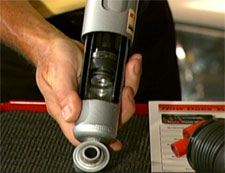Replacing Those Shocks
PAT GOSS: There’s an age-old test to check for the conditions of shocks and struts on a car, but that may not be the best way to do it anymore. Here to give us some pointers is Mac McGovern from KYB America. Mac, welcome to Goss’ Garage.
MAC McGOVERN, KYB AMERICA: Thanks for having me here today.
GOSS: All right, so the bounce test: why does it fail?
McGOVERN: You know originally we called this test the bounce and jounce test and what it is basically is when you take one corner of the vehicle and move it aggressively up and down to release that movement and then see how many times it moves to recover. It was a test we’ve been doing for years to estimate the condition of shocks and struts.
GOSS: All right, but that really only checks part of the shock or the strut, right?
 McGOVERN: That’s a very good point. In fact here we have an example of a twin tube shock and strut from KYB, and the way it works is basically one end is attached to a wheel on the other end into the body. It’s moving up and down with every body movement, every wheel movement. It moves actually anywhere from 1,500 to 1,900 times a mile, and inside the valving that moves the hydraulic fluid to each side of the piston are a series of valves. There’s a first, second, third stage, and sometimes even more. The second and third stages are the real work horse, the ones that control those heavy movements, big bumps and all.
McGOVERN: That’s a very good point. In fact here we have an example of a twin tube shock and strut from KYB, and the way it works is basically one end is attached to a wheel on the other end into the body. It’s moving up and down with every body movement, every wheel movement. It moves actually anywhere from 1,500 to 1,900 times a mile, and inside the valving that moves the hydraulic fluid to each side of the piston are a series of valves. There’s a first, second, third stage, and sometimes even more. The second and third stages are the real work horse, the ones that control those heavy movements, big bumps and all.
And really that’s what you are checking with the bounce and jounce test. But the valve that works the hardest is the first stage. The one that is controlling all that little bit of tire movement, that little bit of body movement. That really adds stability to the vehicle. That’s the one we’re concerned about but you can’t really check it with the bounce and jounce test.
GOSS: Okay, well if we can’t do it with the bounce test, what do we do?
 McGOVERN: Well the best way is to give it a good road test, and what you want to be looking for is a variety of conditions. Certainly that harshness or buckboard ride that might be caused by that first valve inside that shock or strut but also the body roll and swerve, nose dive on braking and acceleration squat as you are leaving a stop sign.
McGOVERN: Well the best way is to give it a good road test, and what you want to be looking for is a variety of conditions. Certainly that harshness or buckboard ride that might be caused by that first valve inside that shock or strut but also the body roll and swerve, nose dive on braking and acceleration squat as you are leaving a stop sign.
GOSS: Essentially all the things that are on your checklist.
McGOVERN: Be sure to look at all of these conditions. But you want to make sure that you’re comparing that current condition of the vehicle to the vehicle’s original capability or what it would be like if you replace the shocks and struts.
GOSS: Well, this is pretty subjective, so this means you want a good, qualified, trained technician to perform the test.
McGOVERN: Excellent point. Someone that understands how that shock absorber is supposed to operate and somebody that’s road tested enough vehicles that they know what it could operate like if you replaced them.
GOSS: Mac, thank you.
If you have a question or comment, write to me or send me a DVD video of your question and you might see yourself on TV.
The address is MotorWeek, Owings Mills, MD, 21117.





